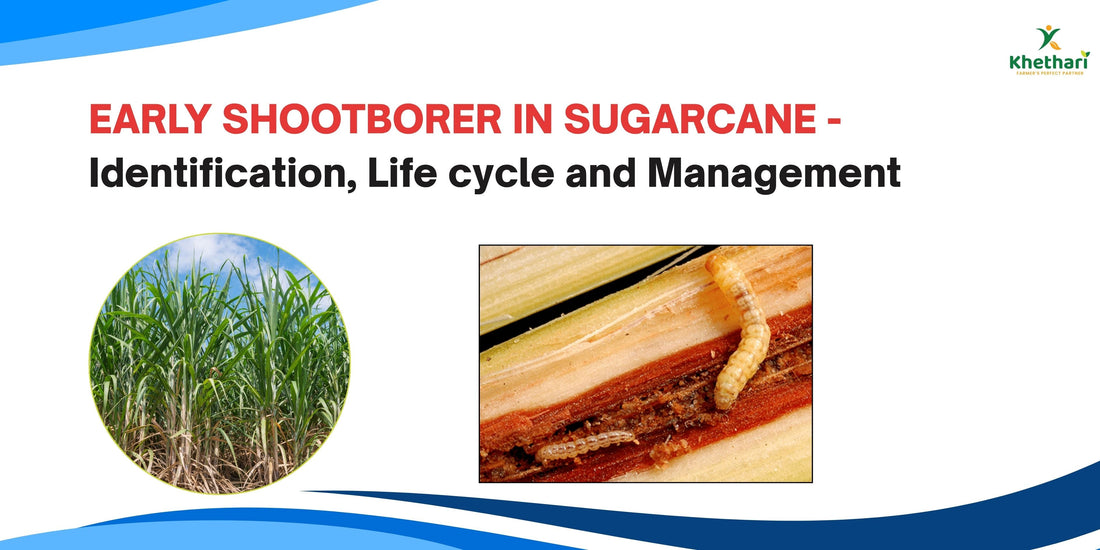
EARLY SHOOTBORER IN SUGARCANE - Identification, Life cycle and Management
1. Introduction
The Early Shoot Borer (ESB), Scirpophaga excerptalis, is one of the most destructive pests affecting sugarcane (Saccharum officinarum) across India and other tropical regions. The larvae bore into young shoots, causing the characteristic “dead heart” symptom, which leads to stunted growth, reduced tillering, and significant yield losses. In severe infestations, ESB can cause 10–40% yield reduction, making timely detection and integrated management essential for profitable sugarcane cultivation.
2. Scientific Classification & Common Names
- Scientific Name: Scirpophaga excerptalis
- Family: Crambidae
- Common Names: Early Shoot Borer, Top Borer, Sugarcane Shoot Borer
This pest is often confused with the Top Shoot Borer (Scirpophaga nivella); however, ESB attacks young shoots rather than fully grown cane tops.
3. Morphology & Identification
Eggs
- Oval, flattened, and creamy white initially; turn yellowish before hatching.
- Laid singly or in small groups on young leaf surfaces or leaf whorls.
- Incubation period: 5–7 days depending on temperature.
Larvae (Caterpillar Stage)
- Creamy white body with brown head capsule.
- Initially 2–3 mm, growing up to 18–22 mm.
- Bore into the central shoot (heart leaf) causing “dead heart.”
Pupae
- Found inside the hollowed central shoot.
- Light brown, cylindrical, ~12–15 mm in length.
- Pupation lasts 7–10 days under normal conditions.
Adult Moth
- Light brown to straw-colored wings with slender body.
- Wingspan: 20–25 mm.
- Active mostly during dusk and night; females lay eggs in leaf whorls of young shoots.
Field Detection Cues
- Presence of small holes and frass in leaf whorls.
- Wilting of the central shoot (“dead heart”).
- Reduced tillering in affected fields.
Larvex Product Link: https://www.khethari.com/products/larvex-insecticide?_pos=1&_sid=0438eff30&_ss=r
4. Life Cycle & Biology
|
Stage |
Duration (days) |
Key Notes |
|---|---|---|
|
Egg |
5–7 |
Laid on young shoots/leaf whorls |
|
Larva |
14–21 |
Bores into shoot; causes dead heart |
|
Pupa |
7–10 |
Inside the hollow shoot |
|
Adult |
7–10 |
Moth emerges, mates at night; lays eggs |
- Generations per year: 3–4, depending on climatic conditions.
- Peak activity: Early crop stages (1–3 months after planting), coinciding with active shoot growth.
5. Host Range & Affected Plant Parts
Primary Host: Sugarcane (all commercial varieties, especially early maturing).
Secondary Hosts: Occasional graminaceous weeds.
Affected Plant Parts:
- Young shoots (central whorl/heart leaf)
- Sometimes, emerging tillers
6. Symptoms & Damage
- Dead heart: Central shoot wilts and dries while outer leaves remain green.
- Stunted growth: Affected shoots do not elongate properly.
- Frass accumulation: Small heaps of sawdust-like frass at the shoot base.
- Reduced tillering: Particularly in severe infestations, leading to low cane density.
- Yield Loss: Can range from 10–40% depending on severity and crop stage at infestation.
7. Monitoring & Detection
Field Scouting:
- Inspect 50–100 randomly selected shoots per hectare weekly during early growth.
- Look for dead hearts, boreholes, and frass.
Traps:
- Pheromone traps: Detect adult moth flight; useful for predicting egg-laying periods.
- Light traps: Attract nocturnal adults; supplementary monitoring tool.
Action Thresholds:
- Seedling stage: If 5–10% of shoots show dead hearts, control measures are recommended.
- Tillering stage: If 10–15% of shoots are affected.
8. Integrated Pest Management (IPM)
A. Cultural Practices
- Use healthy, pest-free setts for planting.
- Avoid planting sugarcane immediately after heavy infested fields.
- Early planting can reduce susceptibility.
- Maintain field hygiene by removing weeds and trash that may harbor larvae.
B. Biological Control
- Parasitoids: Trichogramma chilonis (egg parasitoid), Telenomus spp.
- Predators: Spiders, ants, and predatory beetles feed on eggs and larvae.
- Entomopathogenic fungi: Beauveria bassiana can be used for larval control.
C. Chemical Control
- Apply selective insecticides as per local agricultural guidelines.
- Prefer granular formulations or seedling treatments to target early-stage larvae.
- Avoid indiscriminate spraying to protect beneficial insects.
D. Mechanical/Physical Control
- Remove and destroy affected shoots to reduce larval population.
- Handpicking is feasible in small fields or nurseries.
9. Prevention & Long-Term Strategies
- Use resistant or tolerant sugarcane varieties where available.
- Ensure nursery sanitation: treat setts with insecticides or biocontrol agents before planting.
- Practice crop rotation to prevent pest buildup.
- Maintain balanced fertilization: healthy plants are less susceptible.
10. Farmer Advisory / Practical Tips
- Regularly scout fields during early crop stages.
- Destroy dead hearts promptly to prevent spread.
- Combine cultural, biological, and chemical measures for sustainable control.
- Maintain records of infestation levels to optimize timing of control interventions.
- Ensure safe handling and proper dosage of insecticides.
11. Conclusion
Early detection and integrated management of Early Shoot Borer (Scirpophaga excerptalis) are critical for minimizing damage in sugarcane. By combining cultural practices, biological agents, and selective chemical interventions, farmers can protect young shoots, enhance tillering, and secure higher yields. Continuous monitoring and field hygiene are the cornerstone of sustainable ESB management

